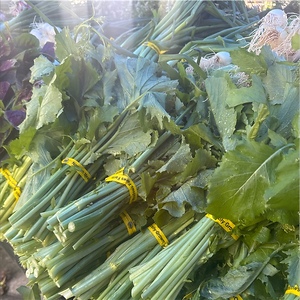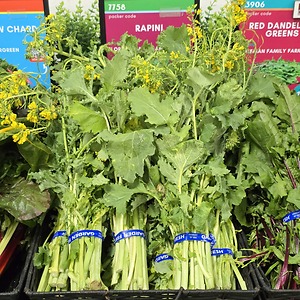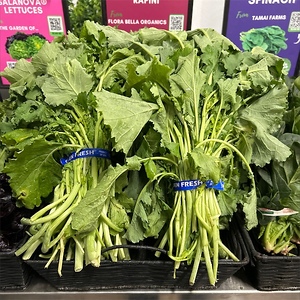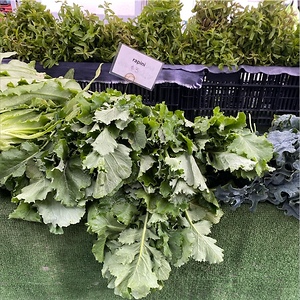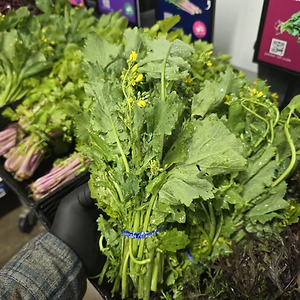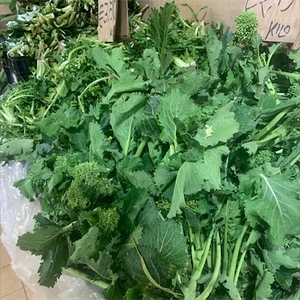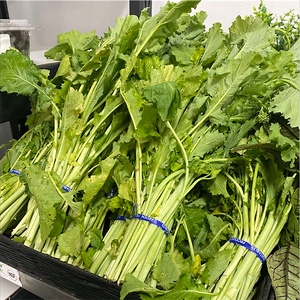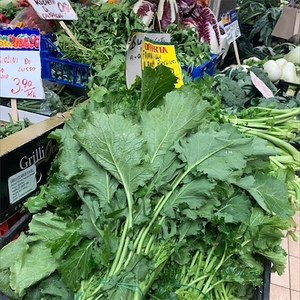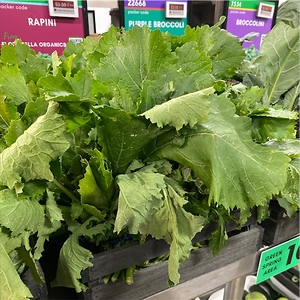


Rapini
Estimated Inventory, 20 ct : 4.55
This item was last sold on : 07/14/25
Description/Taste
Rapini consists of elongated, uniform stalks that bear large leaves and a few clusters of unopened flower buds. The vegetable averages 15 to 25 centimeters in length and is generally harvested young. Rapini does not form large heads like broccoli and instead has a few small groupings of buds that have a crisp, tender consistency. Depending on when it is harvested, some bud clusters may contain a few blooms of tiny, yellow, edible flowers. The long, pale green stems are somewhat slender but have a firm, crunchy, dense, and slightly fibrous texture. Dark green leaves are also attached to the stems and have a chewy mouthfeel with a crinkled, veined surface, bordered with frilled, jagged edges. Rapini is entirely edible, including the leaves, buds, and stems, and bears a sharp, bitter and earthy flavor. Younger greens will have a milder taste, and when cooked, Rapini develops a subtly nutty, almond-like flavor with peppery, pungent undertones.
Seasons/Availability
Rapini is available year-round, with a peak season in the late fall through early spring.
Current Facts
Rapini, botanically classified as Brassica rapa var. Ruvo, is a cool-season, sharp-tasting vegetable belonging to the Brassicaceae or mustard family. The variety produces long stalks, large leaves, and small, clustering green buds, often leading consumers to incorrectly relate it to broccoli. While Rapini and broccoli belong to the same cruciferous family, they are different species. Rapini is closely related to turnips and is also known by several other names, including Broccoli Rabe or Raab, Broccoletti, Cime di Rapa, Friarielli, Rappi, and Ruvo Kale. The entire plant is edible, including the leaves, stem, and unopened flower buds. Rapini is prominently used in Italian, Portuguese, and Chinese cooking and is favored by chefs for its sharp, vegetal, and bitter flavor profile.
Nutritional Value
Rapini is an excellent source of vitamin K to assist in faster wound healing and vitamins A and C to strengthen the immune system, boost collagen production, and reduce inflammation. The sharp-flavored vegetable is also a good source of fiber to stimulate the digestive tract, potassium to balance fluid levels in the body, and provides other minerals, including iron, calcium, and folate.
Applications
Rapini has a sharp, bitter, and nutty flavor best suited for cooked applications, including steaming, roasting, boiling, sautéing, and braising. The stems, leaves, and clustering buds are all edible, and it is recommended to trim the stems to remove fibrous pieces. It is important to note that younger greens will have a less bitter taste, but the pungency of the mature greens can be lessened by blanching in salted water. Once blanched, Rapini can be prepared similarly to turnip greens. Rapini is popularly steamed and mixed into pasta, used as a topping over pizza, stuffed into calzones, or layered as filling into lasagna. The cooked greens can also be stirred into pureed legumes or polenta, simmered in soups, mixed into stir-fries, cooked with eggs, or tossed with sweeter greens to make a fresh side dish. In Italy, Rapini is frequently combined with peppers and sausage to create a dynamic sandwich. It is also blended into a variation of pesto and used as a spread, sauce, and dip. The bitter flavor of Rapini complements acidic, sweet, fatty, and salty foods. The vegetable successfully pairs with hard cheeses such as pecorino, parmesan, and grana padano, meats such as pork, fish, and veal, cherry tomatoes, potatoes, peppers, raisins, olives, and garlic. Unwashed, raw Rapini will keep 5 to 7 days when wrapped in plastic and stored in the refrigerator’s crisper drawer. The vegetable can also be blanched and frozen in a sealed container for 3 to 6 months.
Ethnic/Cultural Info
In As Pontes, a small town in the autonomous community of Galicia in northwest Spain, an annual Rapini Festival, or Feira do Grelo, honors the favorite regional vegetable. The festival was established in 1981 and takes place in February during peak Rapini season. Rapini is regarded as one of the town’s most famous culinary ingredients, and the festival highlights the vegetable through live entertainment and contests to determine the best locally grown Rapini. Festival visitors can also sample traditional dishes of the region using Rapini. Caldo gallego or Galician broth is a comforting soup comprised of potatoes, beans, and Rapini, simmered in a flavorful base made from cooking ham and veal bones. Caldo gallego is consumed year-round in Galicia and is an everyday, inexpensive, and hearty meal. Rapini is also served in lacon con grelos or pork shoulder with Rapini. Lacon con grelos is a traditional meal served at family gatherings on Sundays during the winter months. It is also a common festival dish served with potatoes and sausages.
Geography/History
Rapini is a descendant of a wild mustard plant and was selectively bred since ancient times for improved flavor and texture. The origins of Rapini are heavily debated, with some experts tracing it to the Mediterranean region, specifically Southern Italy, while other experts link it to China. Both regions have been using the bitter vegetable in culinary applications for centuries and consider Rapini to be deeply intertwined into their culture. Rapini also spread from Italy into Spain and Portugal was later introduced to the United States in the late 1920s. D’Arrigo Brothers, Italian immigrants and businessmen who originally introduced broccoli to the United States, began growing the bitter vegetable in California in hopes of bringing another successful Italian vegetable to Italian-American households. With its initial introduction into American markets, Rapini was slow to be accepted and did not see commercial success until the 1960s. Rapini was also registered under the name Broccoli Rabe by the D’Arrigo Brothers in 1964. Today Rapini is still widely cultivated in Southern Italy, China, and Hong Kong. The sharp-flavored variety is also grown in Spain, Portugal, Canada, and in the United States, primarily in California, through specialty farms and home gardens. Rapini can be found through select supermarkets, wholesalers, and farmer’s markets.
Featured Restaurants
Restaurants currently purchasing this product as an ingredient for their menu.
| Boujiemana | San Diego CA | 415-710-0510 |
| InterContinental San Diego | San Diego CA | 619-501-9400 |
| Bencotto Italian Kitchen | San Diego CA | 619-822-5493 |
| Food by Chef Ty | Vista CA | 424-278-8626 |
| Pazza Market & Cucina | San Diego CA | 619-436-7618 |
| Make Stuff Good | San Diego CA | 949-547-9470 |
| Viejas Casino Grove Steakhouse | Alpine CA | 800-295-3172 |
| InterContinental Vistal Kitchen | San Diego CA | 619-501-9400 |
| Pendry SD (Lion Fish) | San Diego CA | 619-738-7000 |
| The Santaluz Club Inc - Banquet | San Diego CA | 858-759-3150 |
| Sandpiper Wood Fired Grill & Oysters | La Jolla CA | 858-228-5655 |
| Siamo Napoli | San Diego CA | 619-300-4810 |
| Blind Lady | San Diego CA | 619-381-4475 |
| The Handmade Chef Meal Prep Co. | San Diego CA | 619-368-3705 |
| Sushi Ota 2021 | San Diego CA | 858-270-5047 |
| Huntress | San Diego CA | 619-955-5750 |
| Trattoria I Trulli | Encinitas CA | 760-277-9826 |
| Isola Pizza Bar | San Diego CA | 619-564-2938 |
| Vista Valley | Vista CA | 760-758-2800 |
| Fairmont Grand Del Mar | San Diego CA | 858-314-1975 |
| BFD-Big Front Door | San Diego CA | 619-723-8183 |
| Gold Finch | San Diego CA | 619-804-2051 |
| Seneca | San Diego CA | 619-588-2411 |
| La Jolla Beach & Tennis Club | San Diego CA | 619-816-8319 |
| Cutwater Spirits | San Diego CA | 619-672-3848 |
| Cal A Vie | Vista CA | 760-945-2055 |
| The Market by Buon Appetito | San Diego CA | 619-237-1335 |
Recipe Ideas
Recipes that include Rapini. One
| Mediterranean Baby |
|
Linguine Fra Diavolo w/Broccoli Rabe and Hot Italian Sausage |



